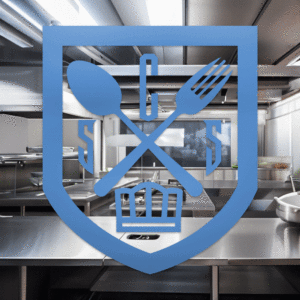
Welcome to the SafeCuisine Solutions’ comprehensive guide to food safety compliance. In this guide, we provide you with insights, strategies, and actionable steps to navigate compliance challenges and maintain the highest standards of food safety. By understanding core violations, practicing proper hand washing, temperature control, safe food storage, and other crucial practices, you’ll be well-equipped to create a safe and thriving dining environment.
Creating a Risk Control Plan:
Before we delve into specific practices, let’s address core violations. These violations, often referred to as 3-point violations, are at the heart of many inspection failures. To tackle them head-on, consider implementing a risk control plan tailored to your establishment:
- Identify the Violation: Clearly define the core violations your establishment has received. This could include improper glove usage, inadequate temperature control, or other key areas.
- Analyze the Cause: Understand the root causes behind these violations. Was it due to a lack of training, oversight, or other factors?
- Develop a Solution: Outline specific corrective actions to prevent these violations from recurring. Consider intensive training, procedure updates, or equipment enhancements.
- Logging and Documentation: Establish a method for logging instances when violations occur and how they were addressed. Maintain detailed records for accountability and future reference.
- Accountability: Clearly define who is responsible for upholding the risk control plan. Assign roles and responsibilities to relevant team members.
- Coaching and Accountability: Involve managers and supervisors in coaching staff members on the importance of adhering to the risk control plan. Regularly review progress and provide feedback to ensure compliance.
Guidelines for Proper Hand Washing:
Inadequate hand washing practices can lead to the spread of harmful pathogens, jeopardizing customer health. Follow these steps to ensure effective hand washing:
- Wet Your Hands: Use warm water to wet your hands thoroughly.
- Apply Soap: Apply enough soap to cover your hands.
- Scrub Thoroughly: Rub hands vigorously for at least 20 seconds, covering all areas.
- Rinse: Rinse hands well under running water.
- Dry Properly: Use a clean towel or air dryer to dry your hands.
- Use Disposable Towel to Turn Off Faucet: To prevent cross-contamination, use the same disposable towel you used to dry your hands to turn off the faucet.
Preventing Bare Hand Contact on Ready-to-Eat Foods:
Direct contact between bare hands and ready-to-eat foods, especially at the food pass, can lead to cross-contamination. This is a particularly common occurrence when handling garnishes, breads, and tortillas. To prevent this, it’s crucial to establish the habit of using utensils, like tongs, instead of hands, to transfer food to the plate. This simple practice can greatly reduce the risk of contamination and protect the safety of your diners.
Encourage your staff to consistently use tongs for transferring ready-to-eat foods. By doing so, you’re actively contributing to a safer dining experience for your customers. At SafeCuisine Solutions, we’re dedicated to helping you implement effective practices that safeguard food safety. If you have any questions or need guidance, our team is here to support you every step of the way. Your commitment to food safety is commendable, and we’re here to help you excel in every aspect of it.
Ensuring Proper Temperature Control:
Maintaining proper temperature control is paramount to prevent the growth of harmful bacteria. Pay close attention to foods that are especially vulnerable to temperature fluctuations, such as garnishes, boiled eggs, and items on steam tables. Common missteps, like leaving boiled eggs at room temperature or neglecting to stir foods on a steam table, can compromise the safety of your offerings.
To address this, ensure that staff are trained to promptly refrigerate or heat foods as needed. Implement regular temperature checks and establish protocols for addressing any deviations from safe temperature ranges. By closely monitoring temperature-sensitive items, you’re taking a crucial step toward maintaining food safety.
Food Storage Practices:
Proper food storage practices are essential for preventing cross-contamination and maintaining food quality. One common violation is storing raw foods above ready-to-eat items, like placing raw chicken over salads. This can introduce harmful pathogens to foods that won’t undergo further cooking.
Follow these guidelines for effective food storage:
- Store Raw Foods Separately: Keep raw meats, poultry, and seafood stored separately from ready-to-eat items.
- Use Color-Coded Cutting Boards: Designate specific cutting boards for different food types to prevent cross-contamination.
- Maintain Proper Refrigeration: Refrigerate perishable foods promptly and ensure they are stored below 41°F (5°C).
- Use Air-Tight Containers: Store foods in air-tight containers to prevent exposure to contaminants.
By adhering to these practices, you’ll minimize the risk of cross-contamination and preserve the quality of your ingredients.
Core Violations and Their Impact:
Core violations, also known as 3-point violations, encompass key areas of food safety. These violations often include improper glove usage, inadequate hand washing, temperature control issues, and more. While some violations may seem minor, they can have a significant impact on the overall safety of your establishment.
For instance, hand washing and glove usage play a pivotal role in preventing the spread of harmful pathogens. Mishandling of gloves, failing to wash hands properly, and direct contact between bare hands and ready-to-eat foods are common culprits. To address these issues, ensure your staff follows proper hand washing protocols and consistently uses gloves to prevent cross-contamination.
Temperature control is another critical area. Foods not kept below 41°F (5°C) or above 135°F (57°C) can become breeding grounds for bacteria. This is especially true for garnishes and items on steam tables. Regular temperature checks, swift action on deviations, and proper heating or cooling methods are key strategies to ensure safe temperatures.
In summary, core violations might appear minor, but they have a substantial impact on food safety. By addressing these issues head-on and implementing effective solutions, you’re taking significant steps toward maintaining a safe and thriving dining environment.
The Importance of Food Handler Certificates and Food Safety Manager Certification:
The foundation of safe kitchen practices begins with proper training. Food handler certificates and food safety manager certification are fundamental requirements for your staff. These certifications provide essential knowledge about proper cooking temperatures, hand washing techniques, cross-contamination prevention, and more.
Food Handler Certificates: These certificates are typically required for all staff members who handle food. They cover basic food safety principles, including proper hand washing, safe food storage, and personal hygiene.
Food Safety Manager Certification: Having at least one staff member with a food safety manager certification is essential. This individual is responsible for overseeing food safety practices, ensuring compliance, and guiding the team to maintain safe practices.
By investing in these certifications and training programs, you’re equipping your staff with the knowledge and skills needed to uphold food safety standards and prevent violations.
Common Violations and Strategies for Prevention:
Understanding common violations that lead to inspection failures is crucial. These violations often include:
- Hand Washing: Inadequate hand washing practices can lead to the spread of harmful pathogens. Ensure proper hand washing is practiced consistently by all staff members.
- Proper Use of Gloves: Mishandling gloves can contaminate food and pose risks to diners. Training your staff on proper glove usage is imperative.
- Bare Hand Contact on Ready-to-Eat Foods: Direct contact between bare hands and ready-to-eat foods can lead to cross-contamination. Encourage proper glove usage and utensil handling to prevent this.
- Temperature Control: Foods not kept below 41°F or above 135°F can become breeding grounds for bacteria. Implementing proper temperature control measures is vital.
- Food Storage Practices: Storing raw foods above ready-to-eat items can introduce harmful pathogens. Maintain a safe food storage hierarchy to prevent contamination.
Remember, addressing these violations requires ongoing training, monitoring, and a commitment to food safety excellence.
Your Path to Compliance:
At SafeCuisine Solutions, we understand the challenges and complexities of maintaining compliance with health department regulations. With our expertise and guidance, you can overcome hurdles and create a dining environment that prioritizes safety and excellence.
By focusing on core violations, practicing proper hand washing, temperature control, safe food storage, and staff training, you’re taking crucial steps toward achieving food safety excellence. Our team is here to support you every step of the way. If you have any questions, need guidance, or want to explore our range of services and resources, feel free to contact us.
Your commitment to food safety is commendable, and together, we can create a dining experience that not only delights your customers but also safeguards their health.
Resources to Excel in Food Safety:
- Risk Control Plan Template: Develop a comprehensive plan to address core violations and ensure compliance. Identify, analyze, and implement corrective actions.
- Food Safety Training: Equip your staff with essential knowledge through food handler certificates and food safety manager certification.
- Temperature Monitoring: Implement effective temperature control strategies to prevent bacterial growth and maintain safe conditions.
- Safe Food Storage Practices: Learn how to store ingredients properly to prevent cross-contamination and preserve food quality.
- Hand Washing Procedures: Master the art of proper hand washing to prevent the spread of harmful pathogens.
- Glove Usage Guidelines: Understand when and how to use gloves correctly to prevent contamination.
- Food Storage Hierarchy: Learn the best practices for storing raw and ready-to-eat foods to prevent cross-contamination.
- Compliance Coaching: Let us guide you through the intricacies of compliance and provide hands-on coaching for your team.
At SafeCuisine Solutions, we’re dedicated to empowering you with the knowledge, tools, and strategies to excel in food safety. Explore our resources and let us partner with you on your journey to maintaining a safe and thriving culinary establishment.

